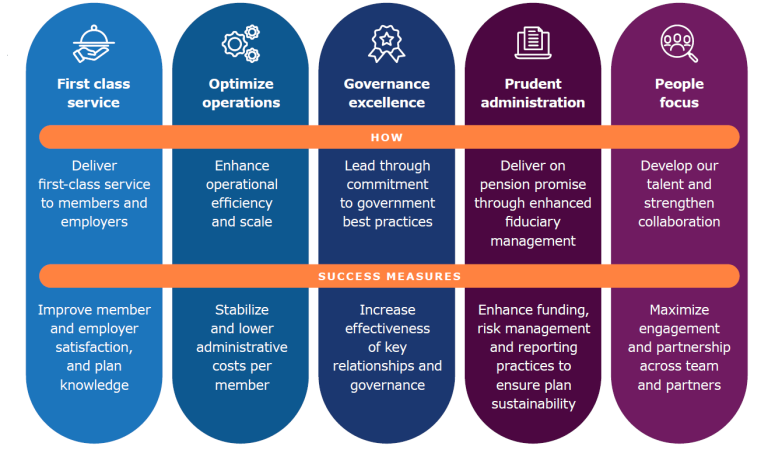Home » About the Plan
Pension definitions
| YMPE | Earnings |
|---|---|
| 2020 YMPE | $58,700 |
| 2019 YMPE | $57,400 |
| 2018 YMPE | $55,900 |
| 2017 YMPE | $55,300 |
| +2016 YMPE | $54,900 |
| Subtotal | $282,200 |
| Divide by five | $56,440 |
The annual average of your pensionable earnings for the highest 60 consecutive months of service during the last 120 months of pensionable service before your retirement or termination from the Plan. If you worked less than 60 months, your best average earnings will be based on your average earnings as a member of the Plan.
A temporary benefit provided to employees who retire prior to the age when unreduced CPP benefits begin. It is paid when you retire from your participating employer before age 65 (even if you collect an early CPP pension). The bridge benefit is payable until the earlier of age 65 or your passing.
Learn more about the bridge benefit.
The CPP is a contributory, earnings-related social insurance program that is paid by the federal government. It provides a measure of income to contributors and their families upon retirement, disability, and death. For further details, contact Service Canada.
The CRA is the federal regulatory agency that administers the Income Tax Act.
The lump-sum value of your earned pension. The commuted value changes based on factors such as age, life expectancy, inflation and interest rates.
An inflation measure computed by Statistics Canada that calculates the change in prices of a fixed set of commodities purchased by Canadians each month. If the combined cost of these goods goes up, inflation increases. The CPI is used to calculate annual cost-of-living increases for pension benefits, also referred to as “indexing”.
A pension plan that defines the ultimate pension benefit to be provided in accordance with a formula, usually based on years of service and earnings. WISE Trust is a defined benefit pension plan.
Learn more on the advantages of a defined benefit pension plan.
Retirement before you reach age 65, in which you may receive a reduced pension or an unreduced pension.
Learn more about this on the retirement page.
An eligible child includes your natural, adopted, or step child in respect of whom you are acting in the role of a parent and who is:
- under age 18; or
- 18 or older but less than 25 and attending full-time, continuous education; or
- 18 or older and suffers from a physical or mental disability that has prevented them from earning a living since reaching 18 or since your death, whichever occurred most recently.
Eligible spouse means, on the relevant date, either of two persons who are
- married to each other; or
- not married to each other but are living together in a conjugal relationship, either:
- continuously for a period of not less than three years; or
- in a relationship of some permanence, if they are the parents of a child, as set out in Section 4 of the Children’s Law Reform Act pursuant to subsection 1 (1) of the Pensions Benefit Act.
On termination of employment, the Plan compares 50 per cent of the commuted value of the member’s deferred pension to the total of their contributions plus interest. If the member’s contributions plus interest equal more than 50 per cent of the commuted value of the pension, then that member is entitled to a refund of the difference, called excess contributions.
An independent regulatory agency, an objective of which is to improve consumer and pension plan beneficiary protections in Ontario.
Learn more about them on FSRA’s website.
The Policy, which is approved by the WSIB and the OCEU as sponsors of the Plan, provides a framework for the financial management of the pension benefits earned under the Plan and the corresponding assets of the trust fund that secure those pension benefits.
A federally legislated act with underlying regulations that outline, among other things, the maximum limits for registered pension plans. The Income Tax Act allows employees and employers to deduct pension contributions from their respective income for tax purposes and sets standards for the benefits a pension plan can provide. It is regulated by CRA.
A method in which pension benefits are adjusted to take into account changes in the cost of living.
A pension plan in which decision making and funding of the benefits is shared jointly by both employees and the participating employer. It’s a pension plan where there is a partnership in the governance of the plan.
The lifetime pension is the amount paid to you for the rest of your life once you retire, inclusive of any further indexation. This amount does not include the bridge benefit, which is paid on top of the lifetime pension up to age 65. Once you reach age 65, the bridge benefit ends and you continue to receive the lifetime pension.
A legislative requirement stipulating that vested entitlements under a pension plan must be used to provide pension payments at retirement and are not available as immediate cash.
A tax-sheltered retirement savings arrangement in which the funds are subject to locking in under pension legislation. Funds in a locked-in retirement savings arrangement cannot be withdrawn prior to the age of 55 and the payment of retirement income from the arrangement must begin no later than the end of the year in which you reach age 71. Examples include annuities, locked-in retirement accounts, life income funds, and other registered pension plans that will accept the commuted value of a deferred pension.
Learn more about this on leaving your employer.
A type of RRSP available to maintain funds that are locked-in as required by pension legislation. These funds must be used to purchase a life annuity or be transferred to a life income fund no later than the end of the year in which you reach age 71.
An employee of a participating employer who is contributing to the Plan or has contributions made on their behalf. Member also includes a former employee of a participating employer who made contributions to the Plan and has either terminated employment or terminated membership in the Plan and (i) retains the right to a deferred pension payable from the Plan or (ii) is receiving a pension payable from the Plan.
This includes the period commencing on the date an employee becomes a member of the Plan until the date the employee terminates the employment that relates to the Plan or terminates membership in the Plan. Any period during which a member was absent from work on a leave of absence, as well as any period of pensionable service transferred into the plan or purchased subject to the Plan’s terms will be included in the calculation of the member’s period of membership. Membership will not be broken for the sole reason that an employee ceased employment with one participating employer and immediately began employment with another participating employer.
An online self-service site for members to log in to view their personal pension details, estimate their pension, request a quote to purchase pensionable service, download forms, tip sheets, the guidebook, and more.
Login to My Pension Resource.
Normal retirement age under the Plan is age 65. The normal retirement age does not compel retirement at age 65, but rather sets the age when unreduced pensions are paid regardless of the years of pensionable service you have under the Plan.
The Workplace Safety and Insurance Board (WSIB), Infrastructure Health and Safety Association (IHSA), Public Services Health and Safety Association (PSHSA), Workplace Safety and Prevention Services (WSPS), Workplace Safety North (WSN), and the Trustees of the Workplace Safety and Insurance Board Pension Plan Fund (WISE Trust).
The deemed value of additional pension benefits purchased for service in previous years. The CRA generally must approve the PSPA before the purchase of additional benefits can be completed and before the purchase can be included in any benefit calculation.
The CRA’s deemed value of the lifetime benefit a member earns during a calendar year under a pension plan, and it affects the member’s RRSP contribution room for the following year.
The pension adjustment is the annual pension amount earned by the member during the year, multiplied by nine, and then the prescribed amount of $600 is subtracted.
The pension adjustment is reported on your T4 tax slip, and your available RRSP contribution room for the following year is reduced by the pension adjustment amount.
Provincial legislation enforced by FSRA, which regulates pension plans in Ontario and determines minimum standards for eligibility, funding, and benefits for Ontario-registered pension plans.
Learn more about the legislation: Pension Benefits Act (PBA).
- the amount of benefits that you are in receipt of under the Workplace Safety & Insurance Act (WSIA) for loss of earnings and any amount supplemented by the WSIB up to the maximum of your regular earnings
- non-bargaining unit lump-sum merit awards
- earnings if you are receiving long-term disability benefits
Pensionable earnings do not include:
- overtime pay
- irregular-hour premiums
- performance bonuses
- job differential pay
- second-language bonuses
- pay in lieu of vacation or Management Compensation Option
- any payment in lieu of a benefit provided by your participating employer
Represents the total years, months and days of service during which you or your employer have contributed to the Plan on your behalf. Subject to the Plan’s terms, it includes any pensionable service you have purchased, transferred in, or service during which you were receiving short-term or long-term disability benefits or while you were in receipt of benefits from a claim filed under the WSIA.
If you are a part-time employee, your pensionable service is calculated as a proportion of the pensionable service that an equivalent full-time employee in the same employment category would accrue. Learn more under pensionable service.
A pension that starts before age 65 and is subject to a reduction for starting your pension early. The reduction for starting your pension early means the pension is reduced by three per cent for each year (and any fraction thereof) your retirement falls before the date you would have qualified for your earliest unreduced pension.
Learn more about this on collecting your pension.
This is a savings arrangement available from most financial institutions that accumulates contributions and investment earnings on a tax-sheltered basis.
The annual statement of earnings and deductions provided to employees and to the CRA by the employer.
The annual statement of pension earnings and deductions provided to retirees and to the CRA by WISE Trust.
An unreduced pension is a pension that is not subject to an age reduction. You may receive an unreduced or lesser reduced pension at age 65 or, earlier provided you have qualified under the early retirement provisions of the factor 85 or 60/20 rule.
Learn more about this on collecting your pension.
A term used in the CPP that refers to the earnings on which CPP and Quebec Pension Plan contributions and benefits are calculated. The YMPE is re-calculated each year according to a formula based on average wage levels. The YMPE is published annually by the CRA.
Canada Pension Plan
A contributory, earnings-related social insurance program that is paid by the federal government. It provides a measure of income to contributors and their families upon retirement, disability, and death. For further details, contact Service Canada.
WTW case management system within eePoint
WTW secure website used to send/receive reports and other confidential member-related data
For more information, refer to subsection 2.5(d)
WTW Pension Administration System.
For more information, refer to subsection 2.5(a)
Financial Services Regulatory Authority of Ontario
An independent regulatory agency whose role is to ensure pension plans meet the legal standard in the Pension Benefits Act (PBA). Their objective is to improve consumer and pension plan beneficiary protections in Ontario.
Income Tax Act
A federally legislated act with underlying regulations that outline, among other things, the maximum limits for registered pension plans. The Income Tax Act allows employees and employers to deduct pension contributions from their respective income for tax purposes and sets standards for the benefits a pension plan can provide. It is regulated by the Canada Revenue Agency (CRA)
Data files that contain employee/member data required to administer pension benefits that are sent bi-weekly from each participating employer to WTW via:
I1 Data File – transmits Demographic & Employment/HR data on a bi-weekly I1 schedule
I2 Data File – transmits Contribution & Payroll data on a bi-weekly I2 schedule
Refer to section 4. Reporting Data and the I1 & I2 Data Interfaces for more information
Jointly Sponsored Pension Plan
A pension plan in which decision making and funding of the benefits is shared jointly by both employees and the sponsor/participating employer. It’s a pension plan where there is a partnership in the governance of the plan. The Plan is a JSPP
Pension Self-Service Pension Website for active, deferred and retired members
Ontario Compensation Employees Union, CUPE Local 1750
Co-Sponsor of the Plan (with WSIB)
Pension Adjustment
The CRA’s deemed value of the lifetime pension benefit earned by a member during a calendar year which affects the member’s RRSP contribution room for the following year. Refer to subsection 6.3 Annual Pension Adjustment Report (I7) for more information
Pension Benefits Act (Ontario)
Provincial pension legislation enforced by FSRA, which regulates pension plans in Ontario and determines minimum standards for eligibility, funding, and benefits for Ontario-registered pension plans
The base salary/compensation received by an employee for their employment position while a member of the Plan.
Refer to X for specific Pensionable Earnings inclusion and exclusions
Note: Contributions must be deducted from Pensionable Earnings in accordance with the Contribution Rate Schedule. Contribution amounts are provided by Participating Employers to WTW for each member via the I2 Data File
Represents the total years, months and days of service during which the employee, or the employer on behalf of the employee, contributes to the Plan or Supplementary Plan and can include service during which an employee is receiving short-term, or long-term disability benefits, or while in receipt of benefits from a claim filed under the WSIA
Determined by the employment statuses for each employee/member as provided by Participating Employers via the I1 Data File, and contributions deducted as provided via the I2 Data File as required, plus any service purchased or transferred in by the employee/member.
Secure File Transfer Protocol
Transmission method by which I1 and I2 Data Files are sent from Participating Employers to WTW
Safe Workplace Associations
Infrastructure Health & Safety Association (IHSA)
Public Services Health & Safety Association (PSHSA)
Workplace Safety & Prevention Services (WSPS)
Workplace Safety North (WSN)
WSIB Employees’ Supplementary Pension Plan (ESPP)
A “top-up” retirement compensation arrangement that provides employees of the WSIB and SWA a pension benefit in excess of the maximum pension benefit permitted under the Plan and the ITA; the Plan and the Supplementary Plan (the “plans”) operate together to provide the same retirement benefit that the employee would have received if the ITA limits did not exist
Sponsored and administered solely by WSIB
Refer to subsection 2.2 The Supplementary Plan for more information
WSIB Employees’ Pension Plan (EPP)
A contributory defined-benefit pension plan registered and regulated under the Ontario Pension Benefits Act (“PBA”) and the federal Income Tax Act (“ITA”)
Jointly sponsored by the WSIB and OCEU and administered by WISE Trust
Refer to subsection 2.1 The Plan for more information
Workplace Safety & Insurance Board
Co-Sponsor (with OCEU) and Participating Employer of the Plan
Sponsor and administrator of the Supplementary Plan
Workplace Insurance and Safety Employee Trust
The Trustees of the Workplace Safety and Insurance Board Employees’ Pension Plan (Board of Trustees)
Legal Administrator of the Plan
Willis Towers Watson
Pension Administration Service Provider for the Plan and the Supplementary Plan
Refer to subsection 2.3 Pension Administration Service Provider for the Pension Plans for more information
About the Plan
Welcome to your WISE Trust pension
You’re one of over 10,000 members of the WSIB Employees’ Pension Plan (the Plan). Plan members are current or former employees of the Workplace Safety and Insurance Board (WSIB), Infrastructure Health and Safety Association (IHSA), Public Services Health and Safety Association (PSHSA), Workplace Safety and Prevention Services (WSPS), Workplace Safety North (WSN) and WISE Trust.
Our values guide us
The WISE Trust mission is to deliver your defined benefit pension now and work to secure it, long into the future. We seek to fulfill our mission for retirement security for all Plan members by providing outstanding service. Our mission statement is underpinned by the values we operate by. Our values help guide the decisions we make and determine the partners we work with.


Our values are:
Being transparent and honest in our decisions and interactions
Acting responsibly today and providing for tomorrow’s future
Delivering timely, positive interactions to members and partners
Working as a team, respecting perspectives, and sharing ideas
Challenging ourselves and our partners to reach beyond the status quo
Strategic Plan
WISE Trust’s 2022-2025 Strategic Plan was approved in late 2021. It establishes strategic direction and sets our priorities for the next four years under five key Pillars.
This Strategy guides our journey of continuing with high levels of member satisfaction, developing a strong culture with highly motivated internal team and external partners, achieving our target of full funding, establishing efficient core business functions, and a clearly defined governance structure.
This Strategy will support our mission to deliver on the defined benefit pension promise now and into the future.


About the Plan
Your WISE Trust pension serves you
The WSIB and the Ontario Compensation Employees Union, CUPE Local 1750 (OCEU), which sponsor the Workplace Safety and Insurance Board Employees’ Pension Plan (the Plan), worked together to convert the pension plan from a single employer pension plan to a jointly sponsored pension plan (JSPP). On July 1, 2020 the conversion came into effect. We believe a JSPP model of pension plan is the right model for Plan members because it strengthens the long-term sustainability of the Plan.
The WISE Trust Board of Trustees (made up of individual trustees appointed by the WSIB and OCEU) is the legal administrator of the pension plan and has a fiduciary responsibility to act in the best interest of pension plan members.
